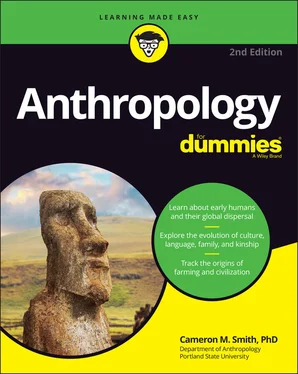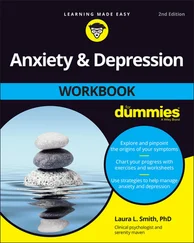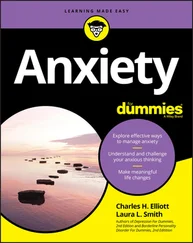Finally, you should be aware of a few conventions I follow throughout the text:
It’s tough to write a book about humanity without using the collective term we, so when I use it, keep in mind that I’m talking about humanity at large and not anthropologists (unless otherwise noted).
I often refer to the past because humanity is an old species, and we can learn a lot from our past. When I do this, I often use the convention BP for “before present” (which basically means years ago). When talking about the history of Western civilization, I use the conventional terms BC for “Before Christ” and AD for “Anno Domini” (which marks the year of Christ’s birth); some people instead use BCE (“Before the Common Era”) and CE (“Common Era”) to avoid valuing the timescale of Western civilization, but these terms still just point exactly to BC and AD. Because so much information about the past uses BC and AD, I stick with this convention. Don’t worry, I’m not pushing a religion or valuing one timescale over another; I’m just using a common way to indicate the passage of time.
The term hominin refers to any of the many species of large, bipedal (walking on two legs) primates; this includes modern humans and all our ancestors and relatives back to the time of our split from the lineage that led to modern chimpanzees. Some earlier texts use the term hominid, but that term is largely replaced today with hominin, and I follow that convention in this book.
Anthropologists often use the terms society and culture interchangeably. I do this as well. It’s an old convention that’s not technically accurate, but unless you’re studying for your PhD, the difference isn’t that important. (Don’t worry; I define both society and culture in the book so you’re aware of the difference.)
When I refer to the scientific names of various life forms, I capitalize the genus but don’t capitalize the species, or subspecies. For example, modern humans are all Homo sapiens sapiens. I don’t always use subspecies names (like the second sapiens ), and sometimes, for convenience, I just indicate the genus with a capital letter while writing out the species name, as in H. sapiens. Don’t worry, this kind of terminology isn’t a large or important point of this book, and these designations will all be very clear when you come upon them.
Within this book, you may note that some web addresses break across two lines of text. If you’re reading this book in print and you want to visit one of these web pages, simply key in the web address exactly as it’s noted in the text, pretending as though the line break doesn’t exist. If you’re reading this as an e-book, you’ve got it easy — just click the web address to be taken directly to the web page.
I don’t think I’m going too far out on a flimsy limb to make these assumptions about you as a reader:
You’re someone — just about anyone who can read, really — interested in the human species. Bring that interest to the reading and you’ll be rewarded.
You’re taking an Introduction to Anthropology course and your textbook just isn’t making things clear; all you want is a friendly, digestible resource that gives you the info you need in plain English.
You either believe that evolution happens or that it’s a sound biological theory. Evolution is the basis of modern biology, and nothing in the world of living things makes sense without it. Even if you have some doubts about evolution, I’m assuming that you can keep your mind open to the fact that humanity is very ancient; evolution is a foundation of the scientific study of our species.
You’re anyone who wants a handy reference to settle a friendly argument about some aspect of humanity. When did the first civilizations arise? How many human languages exist? What did our earliest ancestors eat? You’ll find these answers and plenty more.
To make this book easier to read and simpler to use, I include some icons that can help you find and fathom key ideas and information.
 Any time you see this icon, you know the information that follows is so important that it’s worth reading more than once.
Any time you see this icon, you know the information that follows is so important that it’s worth reading more than once.
 This icon presents historical, case-specific, or otherwise interesting information that you can read for further understanding; however, the info isn’t necessary for grasping the concept.
This icon presents historical, case-specific, or otherwise interesting information that you can read for further understanding; however, the info isn’t necessary for grasping the concept.
 This icon warns about potential traps that can derail you in your quest to understand anthropology.
This icon warns about potential traps that can derail you in your quest to understand anthropology.
In addition to the material in the print or e-book you’re reading right now, this product also comes with a free Cheat Sheet for information on how anthropologists group the early hominins, linguistic anthropology, and more. To access the Cheat Sheet, go to www.dummies.com and type Anthropology For Dummies Cheat Sheetin the Search box.
I’ve organized this book so that you can go wherever you want to find complete information. Want to know about the evolution of civilization, for example? Check out Chapter 10. If you’re interested in Neanderthals and why they became extinct, you want Chapter 7. If the complexities of language or religion flip your switch, head for Chapter 13or 16. You get the idea. You can use the table of contents to find broad categories of information or the index to look up more specific topics.
If you’re not sure where you want to go, you may want to start with Part I. It gets you started with what anthropology studies, and how, and you can follow your interests from there.
Part 1
IN THIS PART …
Get an overview of anthropology.
Understand the history of anthropology.
See how anthropology is studied today.
Chapter 1
Human Beings and Being Human: An Overview of Anthropology
IN THIS CHAPTER
 Discovering what anthropology is and how it studies the human species
Discovering what anthropology is and how it studies the human species
 Exploring the Indiana Jones stuff: Physical anthropology and archaeology
Exploring the Indiana Jones stuff: Physical anthropology and archaeology
 Checking out how cultures and languages fit into anthropology
Checking out how cultures and languages fit into anthropology
 Finding out how modern anthropology analyzes human issues today
Finding out how modern anthropology analyzes human issues today
Why isn’t everyone the same? Why do people worldwide have differences in skin and hair color and ways of greeting one another? Why doesn’t everyone speak the same language? Is there such a thing as “human nature”?
Questions like these have fascinated humanity for as long as we have written records — and I’m sure people thousands and even tens of thousands of years before writing asked the same questions (in whatever language they used). Why don’t those people do things the way I do? What’s wrong with them, anyway? Of course, people from that other group just on the next hilltop were scratching their heads and asking the same questions.
Читать дальше

 Any time you see this icon, you know the information that follows is so important that it’s worth reading more than once.
Any time you see this icon, you know the information that follows is so important that it’s worth reading more than once. This icon presents historical, case-specific, or otherwise interesting information that you can read for further understanding; however, the info isn’t necessary for grasping the concept.
This icon presents historical, case-specific, or otherwise interesting information that you can read for further understanding; however, the info isn’t necessary for grasping the concept. This icon warns about potential traps that can derail you in your quest to understand anthropology.
This icon warns about potential traps that can derail you in your quest to understand anthropology. Discovering what anthropology is and how it studies the human species
Discovering what anthropology is and how it studies the human species










